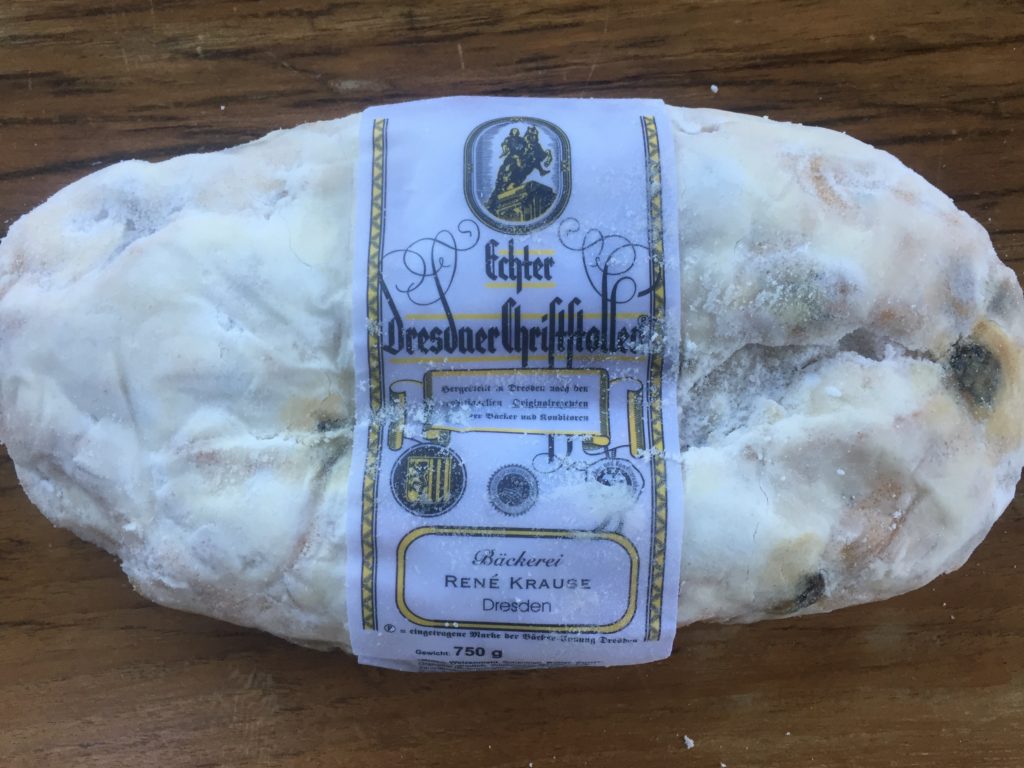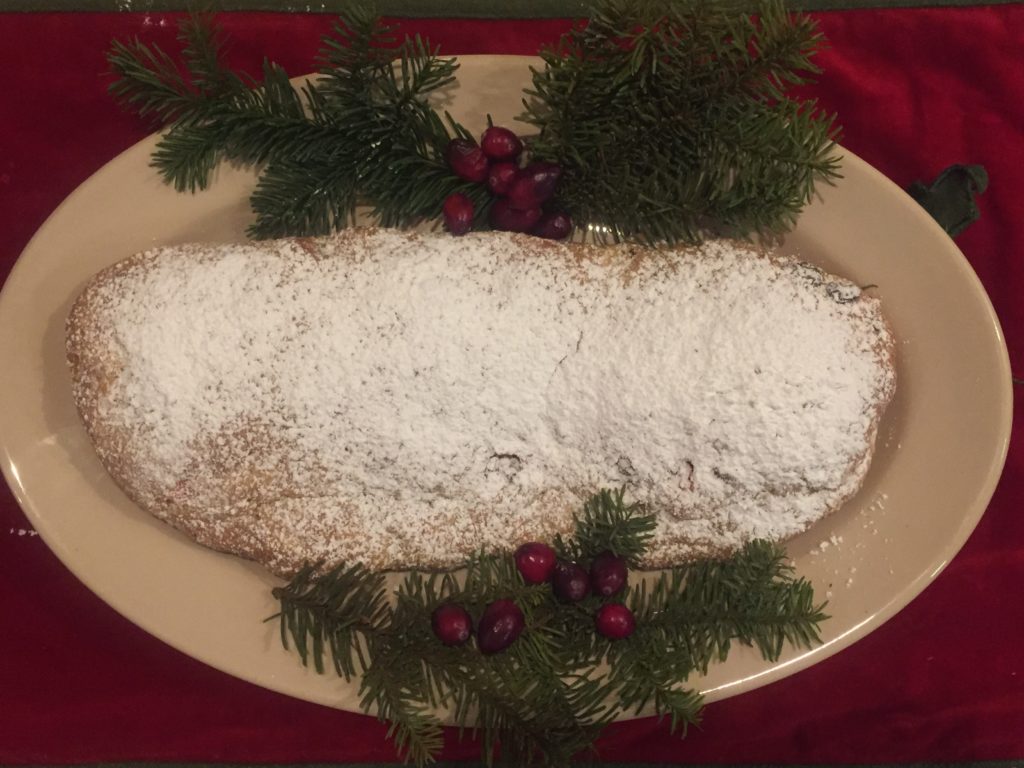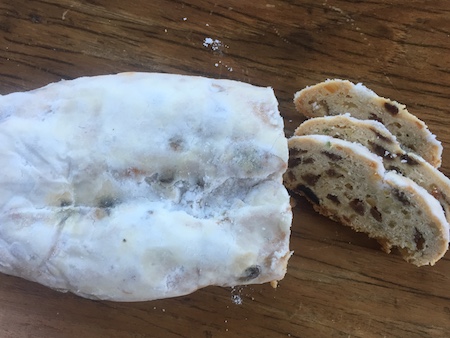On my recent trip to Germany to visit the Christmas markets, I planned a trip to Dresden for one of the country’s oldest Christmas markets — the Dresden Striezelmarkt. The first Striezelmarkt lasted only one day in 1434, but is still going strong today. It truly is a magical place to be. As luck had it (or, maybe my fabulous planning), as soon as we stepped out of our hotel, we could find ourselves immersed in the Dresden Striezelmarkt. There were delights at every turn — lights, handmade gifts, gluhwein, and local foods, including the famous stollen.
The name Striezelmark goes back to the cake – Dresden Christstollen. In old German, ‘strutzel’ or “striezel’ has a characteristic oblong shape, that is tapered at each end, and a ridge down the center – a shape that is said to represent the Christ Child in swaddling clothes. It is linked to Dresden and its cultural heritage, first recorded as being prepared in medieval times. At that time, fasting foods were less than sumptuous, made only from flour, yeast and water – the Catholic church didn’t allow butter or milk to be used (a sign of abstention during advent). In later times, the government asked Pope Innocent VIII to revoke the ban on butter. He did grant their wish, and his butter missive (called the Butterbrief) was sent to Dresden in 1491. From that time on, stollen bakers were also allowed to use richer ingredients. The rest is history, and the Dresdener Stollen gained a reputation for being fit for kings.
While Mom and I made it to Dresden this year, we were unable to be there for the 25thStollen Festival (December 8), which featured a parade through the Old Town, and The Royal Master Baker and the Dresden Stollen Girl cut the first slice of the giant stolen. A parade of hundreds of people stretches from the cities loveliest sights carrying a stollen weighing 12 kilos – 1.6 meters in length, to the festival. The cake is cut using a special Stollen knife, and the pieces of the cake are then sold –The Stollen Association donates most of the proceeds to a charity and to support the upcoming generation of young bakers.

This Christmas specialty is made from a rich, sweet yeast dough that is mixed with milk egg, sugar and butter (sometimes lemon), then raisins, currants, candied peel and almonds are worked into the dough.
Dense and somewhat heavy, Mom and I each brought back our own Dresden Stollen to enjoy at home. And, because I didn’t get a chance to be there during the 25thannual Stollen Festival, I’ve also decided to try my hand at making my own, perhaps starting a new family tradition here in Northern California –although it wasn’t 12 kilos in size!
This is a recipe I used, from King Arthur Flour
Stollen

Sponge
- 1 cup all-purpose flour
- ½ cup water
- 2 tsp instant yeast
Dough
- 2-1/2 cups all-purpose flour
- ¼ cup butter, diced
- 1 large egg
- ¼ cup milk
- 1/3 cup sugar
- 1-1/4 tsp salt
- 4 tsp instant yeast
- 1 tsp almond extract
- 1 tsp vanilla extract
- ½ cup chopped dates
- ½ cup golden raisins
- 1/3 cup candied cherries, coarsely chopped
- 2 Tbsp all-purpose flour
- ½ cup slivered almonds, toasted
Topping
- 1-1/2 Tbsp butter, melted
- Confectioners’ sugar
To make the sponge, combine the flour, water and yeast in a large bowl, stirring until smooth. Cover and let the mixture rest overnight a room temperature.
To make the dough, add the flour, butter, egg, milk, sugar, salt, yeast, almond extract and vanilla to the sponge. Stir to combine, then knead thoroughly, using your hands, a mixer, a food processor or a bread machine, until the dough is very smooth and supple.
Transfer the dough to a lightly greased bowl, cover the bowl, and allow the dough to rise for 1 to 1-1/2 hours. It probably won’t double in bulk, but will become puffy.
While the dough is rising, stir together the dates, raisins, cherries, flour and almonds. Transfer the dough to a clean, lightly greased work surface. Knead the fruit into the dough until it is well distributed; a good way to do this is to pat or roll the dough into a rough 12” X 15” rectangle, press the fruit and nuts evenly over its surface, then roll it up like a jelly roll, starting with the log edge. Divide the roll into 2 pieces, shape each piece into a rough 9” log, cover the logs and let them rest for 10 minutes.
Pat each log into a 10” X 8” oval. The fruit may try to ‘fallout’ of the dough; that’s OK, just stick it back in. Fold each oval lengthwise, bringing one side over the over, but leaving a 1” gap, as if you were making a Parker House roll (in other words, fold the dough not quite in half). Press the edge of the top half to seal it to the bottom half, tent the dough with a lightly greased wrap, and allow it to rise for 2 hours, or until it’s noticeably puffy.
Preheat the oven to 350 degrees F.
Bake the stollen for 30-35 minutes, tenting it with aluminum foil after 20 minutes if it appears to be browning too quickly. The finished loaves should be golden brown, and their internal temperature should register 190 degrees F on an instant-read thermometer.
When the stollen are cool, dust them heavily with confectioners’ sugar.
Wrap well and store for up to 2 weeks at room temperature, or freeze for up to 3 months.








